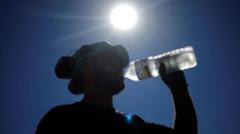Extreme heat is blanketing Europe, with countless individuals poised to face several more days of hazardous temperatures. The most severely impacted countries include France, Italy, Portugal, and Spain, with forecasts indicating that the oppressive heat will persist throughout the week. Here’s an overview of the current situation:
**Impacted Regions:**
Current health and fire warnings are prevalent across Europe.
- **Portugal:** Forecasts predict that temperatures could soar to 111 degrees Fahrenheit (44 degrees Celsius) in Beja on Monday, as per the Portuguese Institute for Sea and Atmosphere.
- **Spain:** The AEMET meteorological agency warned of significant risks as certain areas could reach up to 108 degrees. El Granado registered a blistering 114.8 degrees over the weekend, possibly marking Spain's hottest June day ever if confirmed.
- **France:** According to Météo-France, “scorching temperatures” are anticipated, with expectations around 104 degrees for several days, climbing further north in the following week.
- **Italy:** The Health Ministry has placed 16 cities under the highest alert level on Monday, with an increase to 17 on Tuesday.
- **Britain:** Experiencing its second heat wave of the year, forecasters predict highs of 93 as attendees return from the Glastonbury festival, coinciding with the Wimbledon tournament. Lack of air conditioning in British homes exacerbates the challenges in enduring the heat.
**Is This Heat Wave Unusual?**
These temperatures starkly transcend seasonal averages. In Rome, typical summer highs reach around 86 degrees, but they're nearing 104 degrees in areas like Tor Vergata. With climate change ongoing, occurrences that were once rare are now becoming commonplace, with meteorologists predicting that Europe should brace for more intense heat waves in the future.
**Safety Recommendations:**
For those without accessible air conditioning, experts advise utilizing water to cool off, maintaining hydration, and applying damp towels to the skin.
- At home, keeping sunlight out—especially during afternoon hours—by covering windows can help. Nighttime ventilation and fan usage are also encouraged.
- It's crucial to minimize heavy outdoor exercise and avoid using stoves during peak hours.
- Awareness of heat-related illnesses is essential, with key symptoms of heat exhaustion including excessive sweating, cold skin, and faintness, while heat stroke presents more severe signs like a body temperature exceeding 103 degrees, confusion, and hot skin.
- Ensure pets and children are protected in the heat by providing water and continual monitoring.
As Europe grapples with this ongoing heat crisis, residents are urged to take necessary precautions to safeguard their health and wellbeing.
**Impacted Regions:**
Current health and fire warnings are prevalent across Europe.
- **Portugal:** Forecasts predict that temperatures could soar to 111 degrees Fahrenheit (44 degrees Celsius) in Beja on Monday, as per the Portuguese Institute for Sea and Atmosphere.
- **Spain:** The AEMET meteorological agency warned of significant risks as certain areas could reach up to 108 degrees. El Granado registered a blistering 114.8 degrees over the weekend, possibly marking Spain's hottest June day ever if confirmed.
- **France:** According to Météo-France, “scorching temperatures” are anticipated, with expectations around 104 degrees for several days, climbing further north in the following week.
- **Italy:** The Health Ministry has placed 16 cities under the highest alert level on Monday, with an increase to 17 on Tuesday.
- **Britain:** Experiencing its second heat wave of the year, forecasters predict highs of 93 as attendees return from the Glastonbury festival, coinciding with the Wimbledon tournament. Lack of air conditioning in British homes exacerbates the challenges in enduring the heat.
**Is This Heat Wave Unusual?**
These temperatures starkly transcend seasonal averages. In Rome, typical summer highs reach around 86 degrees, but they're nearing 104 degrees in areas like Tor Vergata. With climate change ongoing, occurrences that were once rare are now becoming commonplace, with meteorologists predicting that Europe should brace for more intense heat waves in the future.
**Safety Recommendations:**
For those without accessible air conditioning, experts advise utilizing water to cool off, maintaining hydration, and applying damp towels to the skin.
- At home, keeping sunlight out—especially during afternoon hours—by covering windows can help. Nighttime ventilation and fan usage are also encouraged.
- It's crucial to minimize heavy outdoor exercise and avoid using stoves during peak hours.
- Awareness of heat-related illnesses is essential, with key symptoms of heat exhaustion including excessive sweating, cold skin, and faintness, while heat stroke presents more severe signs like a body temperature exceeding 103 degrees, confusion, and hot skin.
- Ensure pets and children are protected in the heat by providing water and continual monitoring.
As Europe grapples with this ongoing heat crisis, residents are urged to take necessary precautions to safeguard their health and wellbeing.






















